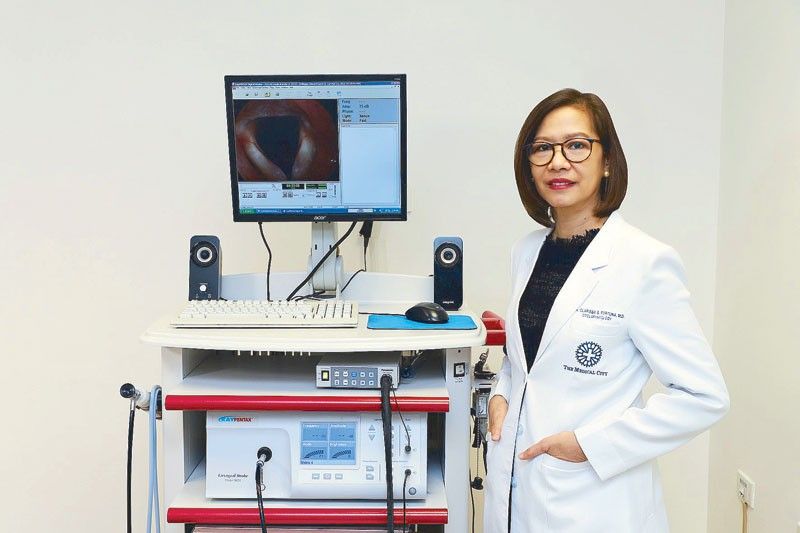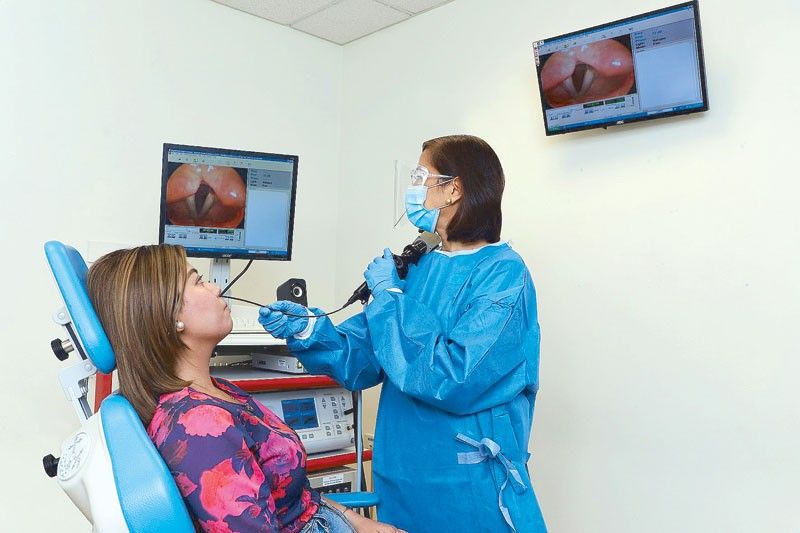How to strengthen your voice in the new normal

Coming from a family of medical professionals, Dr. Clarissa Fortuna was driven by inspiration. During holidays while in grade school, she spent most of her time in her father’s clinic doing prescription writing and when she reached high school, she was already observing her parents, doctors Antonio Bello Fortuna (a general surgeon) and Erlinda Santos Fortuna (an obstetrician-gynecologist), perform surgeries. With early clinical exposure, Dr. Fortuna knew that medicine was the career for her. “In hindsight, I have no regrets being a member of one of the most noble and time-honored professions,” she shares.
Dr. Fortuna is a board-certified otolaryngologist-head and neck surgeon. She obtained her Doctor of Medicine degree at the UST Faculty of Medicine and Surgery. She took her fellowship training in laryngology and care of the professional voice at the Vanderbilt University Medical Center in Nashville, Tennessee, and at the Tokyo University Hospital. She is the former director of the Ear Nose Throat Head and Neck Institute at The Medical City and is currently a senior consultant at its Center for Voice and Swallowing.
For the past two years, the implementation of COVID-19 protective measures such as social distancing, face shields and masks have helped curtail its transmission, but has had a deep impact on our interpersonal communication. Vocal health consequences include reduced intelligibility and clarity of speech and a decrease in frequency.
Here are some vocal hygiene tips to optimize voice production as we transition to post-pandemic life:
1. Hydration. Adequate hydration is essential for optimal voice. The recommended daily intake is eight to nine glasses (an eight-ounce glass). Add more if you’re active and engage in activities that can cause excessive sweating. Since coffee and caffeinated beverages draw water from your body, be mindful of your consumption and take more water to offset its drying effect. Technically, our body needs to be rehydrated constantly so make sure you take off your mask every 45-60 minutes to hydrate. Figure out a routine that works for you.
2. Nasal sprays and rinses. Studies have shown that prolonged use of facial masks can increase resistance and cause nasal blockage. Medical-grade masks like the N95 used by healthcare workers can produce postnasal discharge. This in turn promotes habitual throat clearing, which is abusive to the vocal cords and can cause hoarseness. The presence of mucus in your sinuses can also affect the resonance of your voice. The over-the-counter (OTC) nasal sprays made of hypertonic saline and rinses have been historically used for relief of allergy symptoms. It can prevent this mask-induced blockage and restore moisture in the nasal passages. Use it at the start of your day and at bedtime or prior to wearing mask.
3. Enhancing communication. Communication through a mask has been quite a challenge for all of us since the pandemic. It muffles our voice volume-wise and covers the mid and lower face, which make up 55 percent of our overall communication through facial gestures. Rather than talking louder, alter your speech rate by speaking slowly and clearly, preferably in a place with low background noise. You can increase your eye expression and utilize non-verbal hand gestures to facilitate the communication process. Healthcare professionals who deal with the elderly or the hearing-impaired on a daily basis should wear transparent masks. Other visual references such as flip charts and whiteboards can also help. If your budget allows, invest in available masks with purifiers and built-in microphones or voice amplification, which allow you to breathe and lessens the strain on your voice.
4. Digital infrastructure. Digital tools or platforms such as audio and video conferencing have grown immensely during the pandemic. The work-from-home (WFH) culture will likely stay even long after the pandemic. If you are in a type of job that is enabled by technology and your work is done via telecommuting, set up a private workspace at home and invest in noise-cancelling “muff type” headphones that block out background noise. This will allow you to speak at a comfortable loudness without causing a strain in your voice. Let your voice box and ears take a break when you’re offline. You need at least 15 minutes of voice nap for every hour of continuous talking. If you’re a teacher and your school is still in online mode, design high-yield asynchronous learning content and interact during synchronous sessions to conserve your voice.

5. It’s okay to sing in the shower. Whether you’re a voice professional or not, you need your vocal folds to be lubricated for better vibration. The steam from the shower creates a humid environment, which moistens your vocal cords and thins out nose and throat mucus as well. Do this before you head off to work with a mask.
6. For voice professionals and the elite vocal performer, always warm up your voice before heavy use or a performance. Warm-ups may be as simple as lip or tongue trills or gliding from low to high tones on vowel sounds. Singing with a mask is doubly challenging. Although performances are now allowed outdoors and indoors (with modifications) masking up is still a requirement. Surgical and cloth masks (two-ply) all reduce high frequencies. Get those specially designed “singer’s masks” or wear a racket or support under your regular mask to allow you open your mouth while singing. Always find a place where you can ventilate and preferably don’t do more than 30 minutes of continuous singing.
7. Listen to your vice. If your voice quality is persistently raspy and you’re experiencing vocal fatigue during speaking, rest and allow your voice to recover.
8. Seek professional help. If your hoarseness is greater than two weeks, you should be evaluated by a voice specialist or an otolaryngologist (an ear, nose, throat physician).
9. Vocal longevity. Your voice is your “signature;” keep it strong. Take care of it the same way you approach your health and wellness. Specific foods weaken the lower esophageal sphincter and cause laryngo-pharyngeal reflux (backflow of acid into the vocal cords). These include spicy food, caffeine, alcohol, chocolate and peppermint.
10. World Voice Day 2022. The theme for this year’s World Voice Day is “Lift Your Voice.” It was proposed by the American Academy of Otolaryngology-Head and Neck Surgery (AAO-HNS), which calls for us to take back our vocal presence with a good voice quality that represents us and improves communication.
(We welcome your suggestions and comments. Please e-mail me at [email protected]. Follow me on Instagram @monsromulo.)
- Latest




























